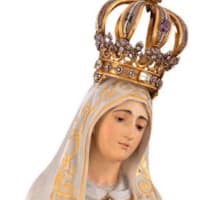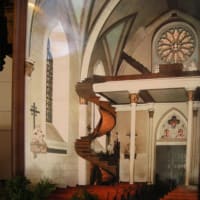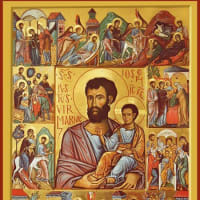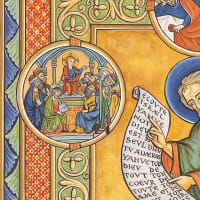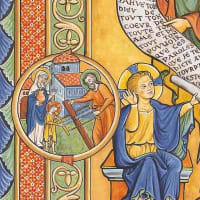四旬節の説教
聖ピオ十世会司祭 ピーター・フォルティン神父
灰を使うことについて、また四旬節について、その教えと歴史を簡単に述べたいと思います。
まず、灰が象徴するものについてです。教会は、悲しみを表すしるしとして、けんそんのしるしとして、また喪に服したり償いをしたりするしるしとして、常に灰を使用してきました。
旧約にはその事例がいくつかあります。天主を目の当たりにして悔い改め、「そのために私は自分の愚かさを捨て、ちりと灰の上で悔やみます」(ヨブ42章6節)と言う義人ヨブの事例です。

さらに驚くべき事例は預言者ヨナの話の中にあります。彼はニネベの町の住民に、「回心せよ、さもなければ町は天主によって滅ぼされることになる」と説教するために天主によって遣わされました。「これがニネべの王の耳に達したとき、彼は王座を立ち上がり、外套を脱いで、袋を身に着け、灰に座った」(ヨナ3章6節)。これは非常に素晴らしい対応です。王はその言葉を受けて、その重要さを理解し、それに応え、さらには全臣民と動物に至るまでもが灰をかぶって断食するという指示に従うよう命じます。
マカバイの書にはまた、人々が次のように戦争の準備をしたことが記録されています。「彼らはその日断食をし、袋をかぶり、頭に灰をまき、服を引き裂いた」(マカバイ前書3章47節)。彼らがこれを行ったのは、勝利を求める祈願をする精神においてだけでなく、多くの人が死ぬことになったとき、彼らがその人生で犯した罪に対する罰が減らされるように願う、償いの精神においてでもあったのです。
教会の初期においては、求道者は、償いのしるしと、復活祭に教会に入るための準備のしるしとして、男は頭に、女は額に灰を受けました。灰の使用は、6世紀には大教皇聖グレゴリオによって教会全体に導入されました。
11世紀には、英国のある修道院長がこう書いています。「古い法(旧約のこと)においては、新しい法(新約)と同じように、人々は自分の罪を悔い改めて自ら灰をかぶった。さて、私たちもまた、四旬節の間には同じようにしなければならないことを表すために、これと同じことをしよう」。
1091年、(第一次十字軍の)教皇ウルバノ二世は、灰の水曜日についてこう書きました。「われわれが灰を受けるとき、われわれは何世紀にもわたるカトリックの実践に従っているのであり、これはわれわれのための償いの戦いを表すためである。われわれはこの戦いすなわち償いから逃れることはできない。われわれはこの瞬間に償いを喜んで引き受け、それを活用しなければならない。われわれは、この聖性を取り入れて、罪に背を向けなければならない。われわれは、灰をかぶって、自分たちがカトリック信者であって罪びとであると宣言した非常に多くの証人の一部とならなければならない」。
カトリック信者である私たちにとって、灰を受けることは、私たちの人生は短く、償いが必要であり、私たちは罪に背を向け、私たちの主イエズス・キリストのもっとおそばにつき従うべきことを、思い起こさせてくれるものです。

四旬節とは何でしょうか? これは、四旬節から望ましい効果を引き出すためには非常に重要な質問です。最も知られた定義は、四旬節は断食の時期であり、断食の中身は食べ物を少なくすることと、同様に肉を控えることである、というものです。ほとんどのカトリック信者の理解は、四旬節とは基本的には食事の制限、あるいはテレビを見たりチョコレートを食べすぎたりといったやめられない楽しみをあきらめる時期だというものです。
四旬節についてのまことのカトリック的な意義は、「何かをあきらめること」をずっと超えるものです。では、四旬節のまことの意義とは何でしょうか? 私たちが食事やある種の食物を控えることによって望む効果は、私たちの体がもっと素早く動き、おなかにもたれる食べ物によって体重が増えすぎないようにすることによって、素早く祈りを始め、また他の霊的活動に取りかかれるようになり、ひいては私たちが天国に行くのを助けてくれるということです。
心においてもっと素早く、体においてもっと素早く、霊においてもっと素早く進めるようになるためです。食べ物を控えることは絶対に必要ですが、それ自体は目的ではなく手段にすぎません。食べ物を控えることは、私たちの情欲を抑え、自分を天主のご意志に従わせることに関わっています。そうすることによって、私たちは自分の感覚を抑制することができ、何が重要なのかをさらによく分かることができるようになるのです。最も重要なのは体ではなく霊魂であって、ですから、断食によって私たちは自分の体を支配し、自分の体を自分の霊魂の善のために抑制するのです。
四旬節は一つの修養であって、私たちが自分の霊的進歩に焦点を当てることができるよう、物質への愛着から自由になるのを助けてくれるためのものです。私たちの主によって制定されたこの偉大かつ聖なる断食は、私たちの霊魂の大きな救いとなるものです。
ですから、主に従って砂漠に入りましょう。それは、自分をこの世の精神から切り離し、ここ地上での私たちの使命に焦点を当て、祈り、そのための力を求め、自分自身と隣人を私たちの祈りと模範によって聖化するためです。
すべてにおいて完全に主にならっておられる聖母が、常に私たちとともにいてくださいます。御悲しみの聖母の称号において、特に聖母に願いましょう。この四旬節の間に、私たちがその終わりには天主なる御子にもっと近づいていることができるよう、私たちを助け、励ましてくださいますように。
【英語原文】
Sermon for Quadragesima
Fr Peter Fortin, FSSPX 1st March, 2020
I will mention a simple instruction and history on the use of ashes and on Lent.
First for the symbolism of ashes. The Church has always used ashes as an outward sign of grief, a mark of humility and also as a sign for mourning or penance.
In the Old Testament we have several examples. The example of the just man Job who repented before the sight of God and says “Therefore, I disown what I have said and repent in dust and ashes.”
A more striking example is given in the story of the prophet Jonah. He was sent by God to preach to the inhabitants of the city of Ninevah to convert or else the city was to be destroyed by God. “When the news reached the king, he rose from his throne and laid aside his robe and covered himself with sackcloth and sat in ashes.” A very excellent reaction. He receives the word, he realizes the gravity, he responds and furthermore orders that all his subjects and even the animals submit to this wearing of ashes and fasting.
In the book of the Machabees is recorded also that the men prepared for battle; “That day they fasted and wore sackcloth, they sprinkled ashes on their heads and tore their garments.” They did this in the spirit of supplication to ask for victory but also in the spirit of penance that in the case that many would die, that their punishment for the sins of their life be reduced.
In the early days of the Church, the catechumens would receive ashes, men on their heads and women on their foreheads as a sign of penance and preparation for them to enter the church on Easter. The use of ashes was introduced universally into the church in the 6th century by Pope St. Gregory the Great.
In the eleventh century is recorded an abbot in England who wrote “In the Old Law (meaning the Old Testament), men repented of their sins and bestowed ashes on themselves as in the New (Testament). Now let us do the same to signify that we must do also (the same) during Lent.”
In the year 1091, Pope Urban II (of First Crusade) wrote concerning Ash Wednesday: When we receive ashes, we are following the practice of Catholics for centuries, this is to mark a battle of penance for us. We cannot run from this battle or penance. We must embrace at this moment the penance and take advantage of it. We must embrace this sanctity and turn away from our sins. We must be part of this great multitude of witnesses who took ashes and proclaimed that we are Catholics and we are sinners.
For us as Catholics the reception of ashes is a reminder of our short life and the need for penance, to turn from our sins and to follow Our Lord Jesus Christ more closely.
What is Lent? A very important question in order to derive the desired effect for Lent. The most popular definition is that Lent is a time of fasting and a fast consists of less food and abstinence from meat as well. The understanding of most Catholics is that it is basically a diet or a time of giving up guilty pleasures like TV or eating too much chocolate.
The true Catholic sense of Lent is much more than “giving up something”. So what is the True meaning of Lent? We renounce some foods and types of food with the desired effect that it help us to heaven by helping the body to be swifter and less weighed down by heavy foods so that it can rise to prayer quickly and attend to other spiritual activities. Swifter in Mind, swifter in body and swifter in spirit to advancement.
Abstaining from food although is absolutely necessary is not the goal in itself but a means. It is concerning controlling our passions and submitting ourselves to the will of God. It allows us to mortify our senses so that we can see more clearly what is important. That which is most important is not the body but the souls and so by the fast we subjugate our body and bring it under control for the good of our souls.
Lent is an exercise meant to help us to break free from the material attachments so that we may focus on our spiritual advancement. It is most salutary for our souls, this great and holy fast instituted by Our Lord. So let us follow Lord into the desert in a manner, to separate ourselves from the spirit of the world and to focus, to pray and ask for strength for our mission here on earth, to sanctify ourselves and our neighbors by our prayers and examples.
We have Our Lady always with us who follows Our Lord in a perfect manner in all things, let us ask especially for Our Lady under the title of Our Lady of Sorrows to assist and encourage us during this Lent that we may be closer to Her Divine Son at the end.










